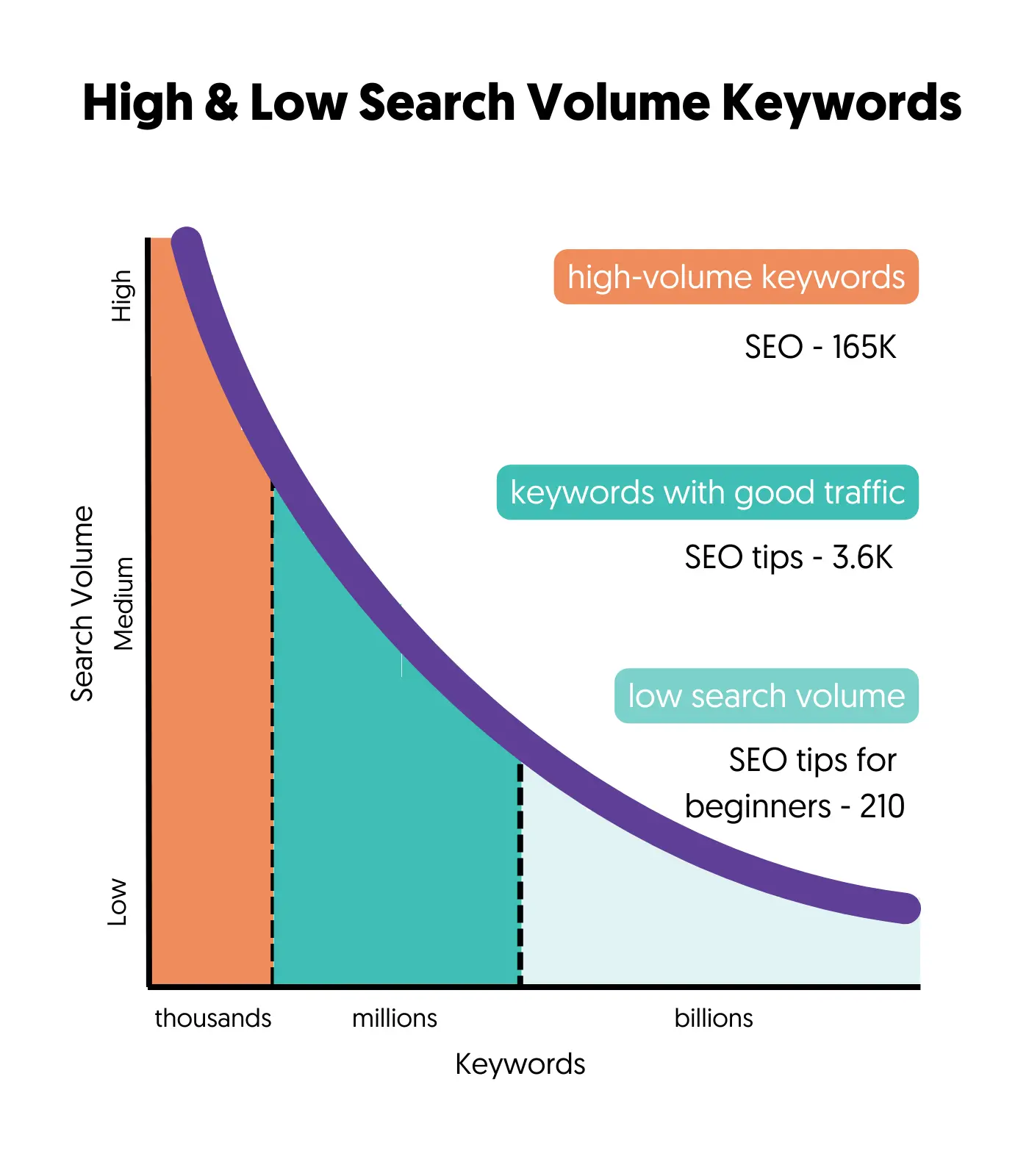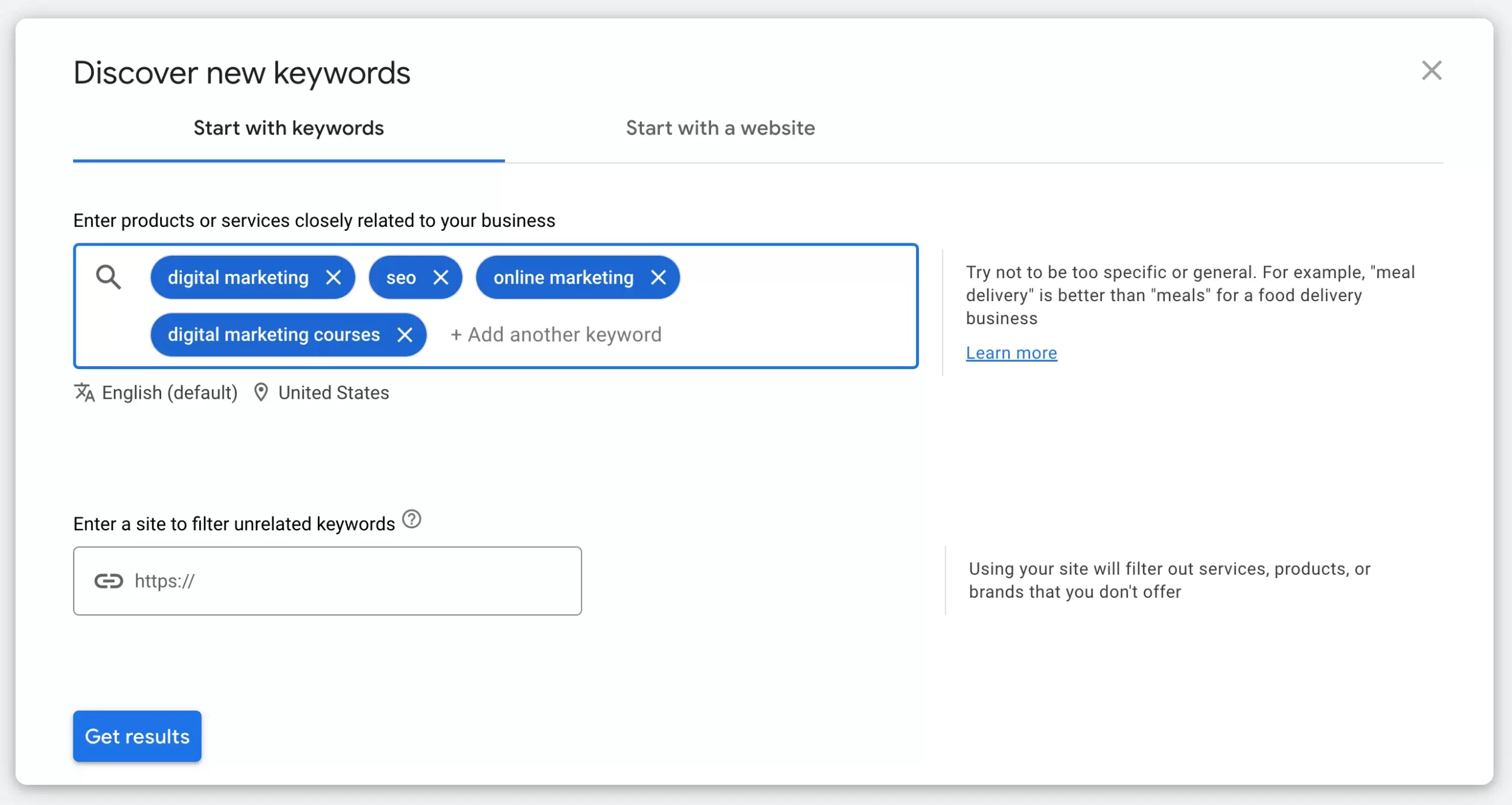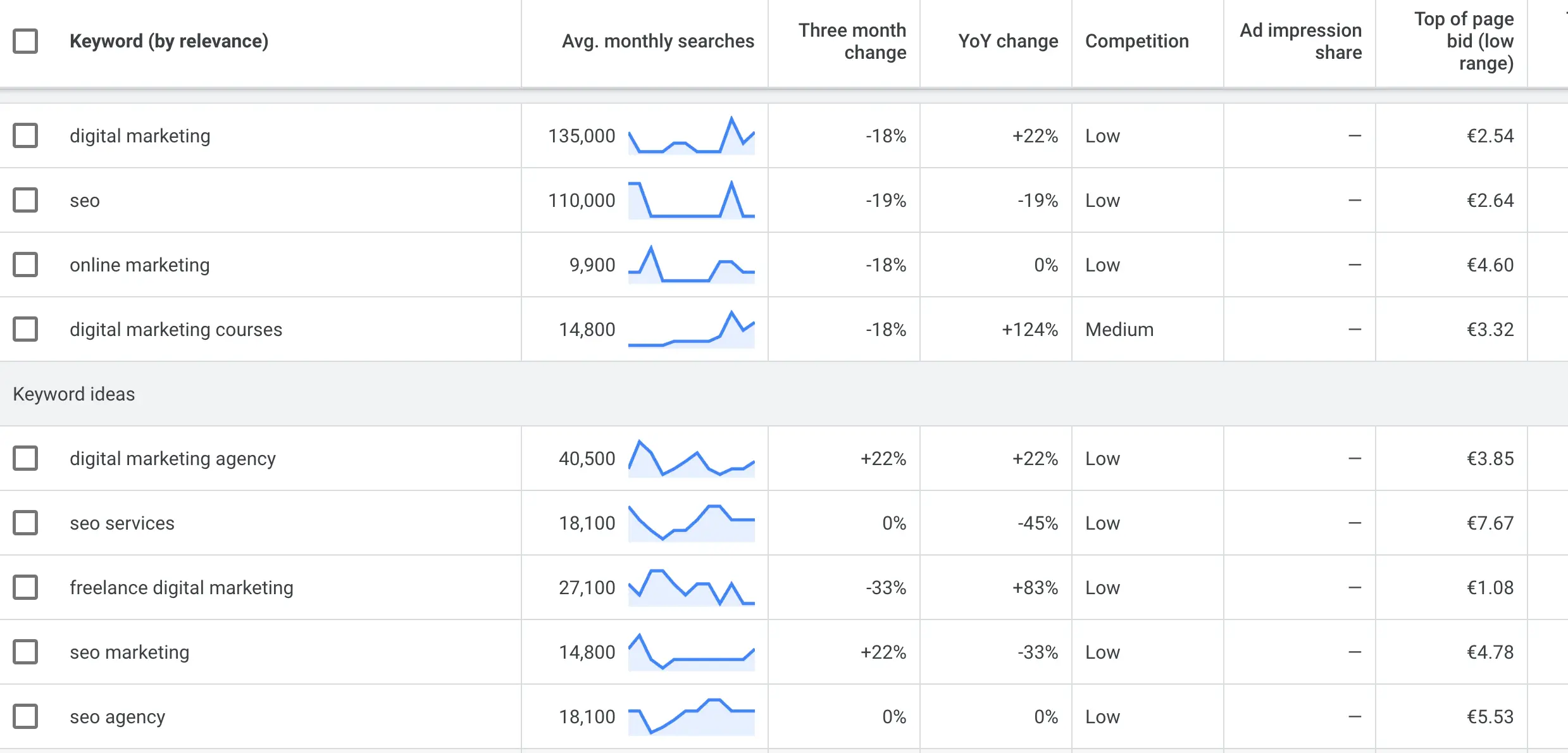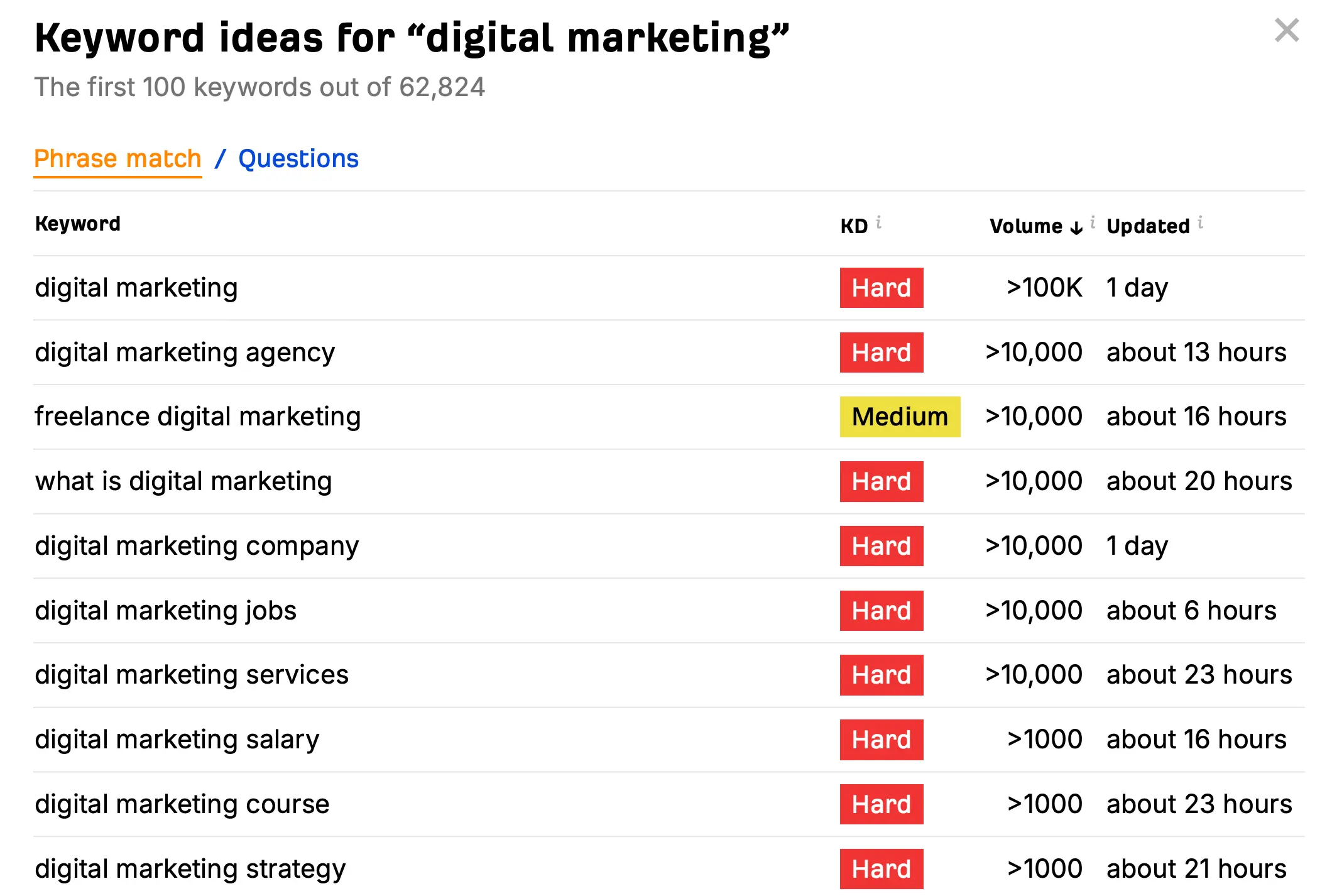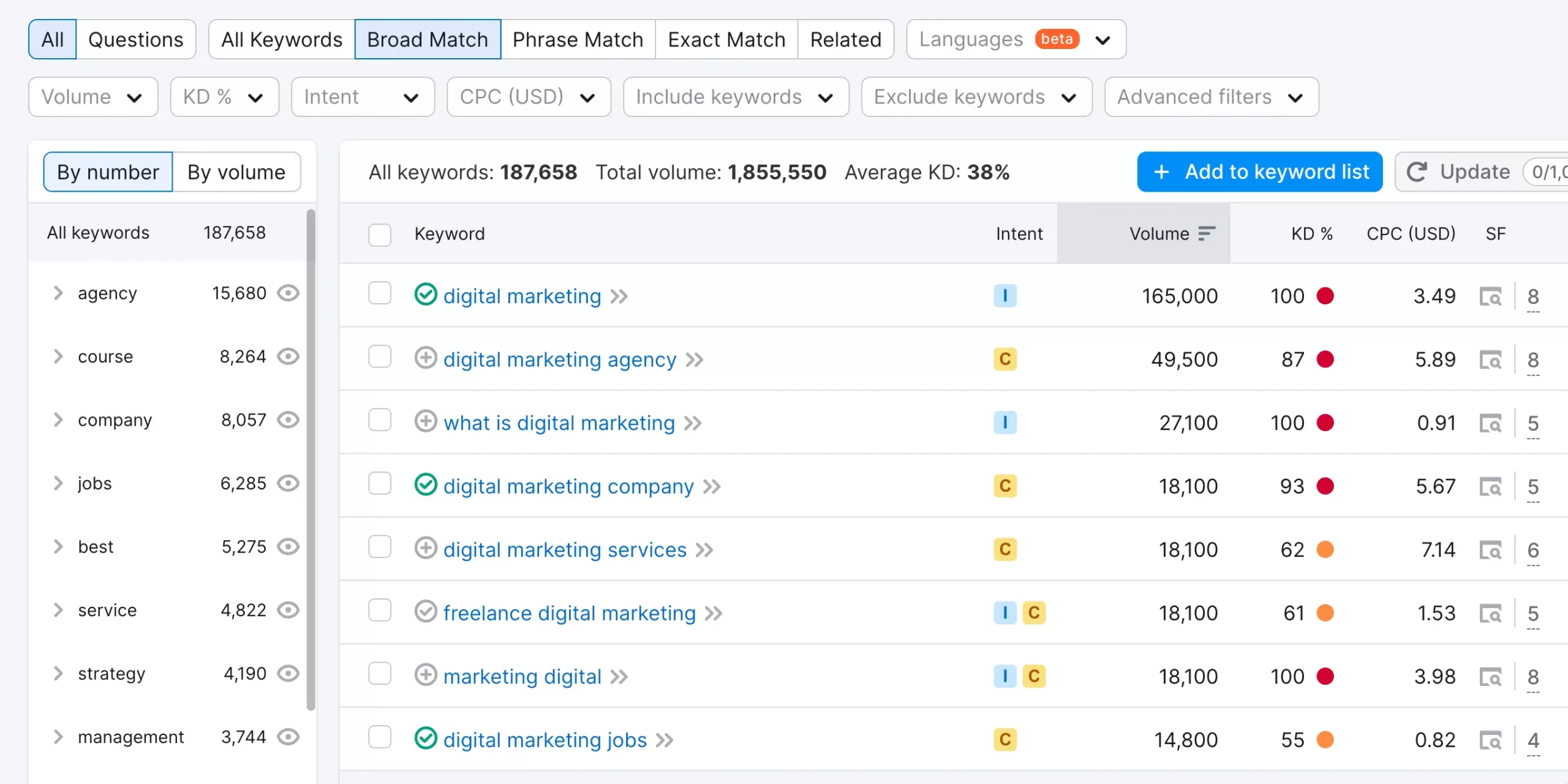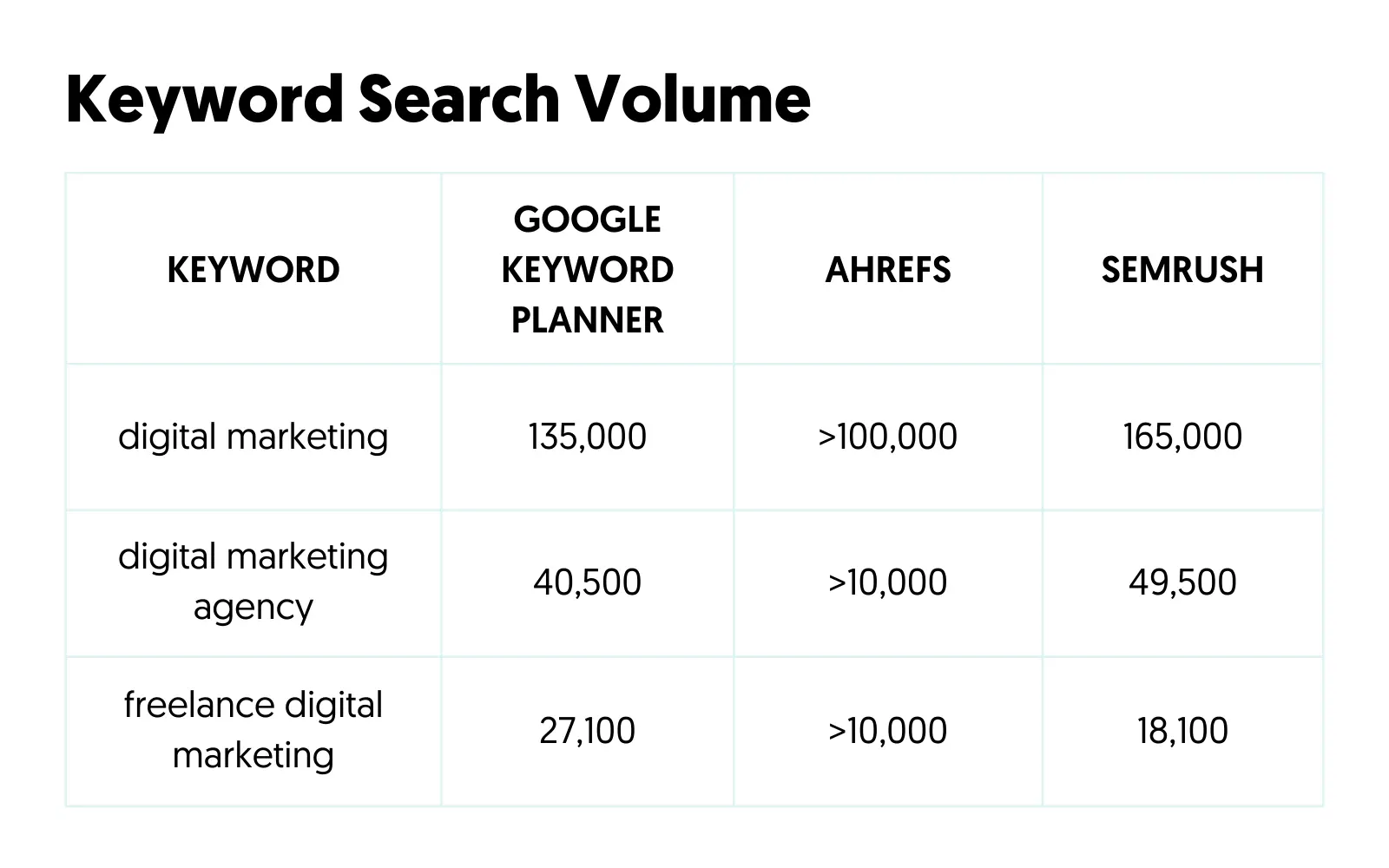What Is a Good Keyword Search Volume? (With Examples)
Whenever you start keyword research, the first metric you usually look at is monthly keyword search volume because it indicates the popularity of keywords. While this is not a bad practice, it’s not always the correct approach.
For starters, keyword search tools don’t always get the volume right, and there are many cases where going after low-search volume or no-volume keywords is a better SEO strategy.
In this guide, you’ll learn what is considered a good keyword search volume and when not to choose keywords for your SEO and PPC campaigns based on monthly search volume.
What Is Keyword Search Volume?
Keyword search volume is the average number of monthly searches performed in Google (or other search engines) for a particular keyword. Most keyword research tools calculate this metric based on the average number of searches made in the last 12 months. You can also view the search volume of a keyword per country and device.
It should be noted that the search volume reported by tools is the total number of times a given keyword was searched for in the particular search engine, location, and device, not the number of people who searched for it.
This means that if 100 people search for a keyword 5 times daily, the total search volume for that keyword will be 15,000 (100X5X30), but in essence, only 100 people search for it monthly.
That’s one reason why when you rank in position #1 of Google for a keyword, the traffic you get is not the same as the recorded search volume.
Another reason is that not all searches result in clicks. Search engines give direct answers to users’ questions through featured snippets, rich results, or even meta descriptions, and as a result, people may not click to visit a website after performing a search.
Why Is Search Volume Important For SEO?
Despite the above issues, search volume is still an important SEO metric. It indicates how popular a niche is (combining the search volume of many keywords) and can help you understand the potential traffic your website could gain if you rank well for those keywords.
Moreover, search volume helps you identify seasonal and evergreen keywords, allowing you to adjust your content strategy accordingly. For example, knowing that certain terms peak during specific times of the year (like Black Friday) enables you to create content or ad campaigns to align with these peaks.
Additionally, search volume can help assess how competitive a keyword is, as higher volumes indicate more competition. Knowing this information can influence your SEO strategy and help you target long-tail keywords with less competition but enough search interest to be valuable.
What Are High And Low Search Volume Keywords?
Before examining how to find and evaluate a keyword’s search volume, we should differentiate between high and low-search-volume keywords.
High-volume keywords are those that are searched more often than others. They are usually phrases made up of one or two words that people search for often in search engines.
Low search volume keywords are searched for less often and consist of more than two words, but they are very specific.
If we were to plot all the searches on a search demand curve, this is how it would look.
For example, the term “SEO” has a search volume of 165K and is considered a high-volume keyword, while the term “SEO tips for beginners” has just 210 searches per month, making it a low-search-volume keyword. In between, keywords like “SEO Tips” with 3.6K are considered medium-volume keywords.
As we’ll see below, search volume is not always important. For many businesses, it makes more sense to target medium and low-volume keywords to fulfill their business objectives.
How To Find The Search Volume of a Keyword?
You need to use a keyword research tool to find the search volume of keywords. There are many free and paid options available. Let’s see how to use the most popular tools:
1. Google Keyword Planner
The Google Keyword Planner is a free tool by Google and is considered the most accurate since the data comes directly from Google.
To run reports, you need an active Google Ads account. If you don’t have an account, sign up for one (it’s free), create a campaign, and keep it paused.
Then go to TOOLS and select KEYWORD PLANNER from the top menu.
Click DISCOVER NEW KEYWORDS and choose your language and location.
Enter the keywords you want to analyze and click GET RESULTS.
The keyword search volume is what you see in the “Avg. monthly searches” column.
Besides the search volume, you can use monthly trends, competition levels, and how much it costs (on average) to get a click from Google Ads for a particular keyword.
Keep in mind that the competition column shows how competitive ad placement is for a keyword, not how easy or hard it is to rank for that keyword in Google organic results.
For more information on how to use this tool, visit our Google Keyword Planner Tutorial.
2. Ahrefs
Another tool for finding the search volume of keywords is the Ahrefs Keyword Generator. This popular tool allows you to search Google, Bing, YouTube, and Amazon and do a more detailed analysis than Google Keyword Planner. To access all features, you need to register for a monthly subscription, but you can also use it for free to get some basic information.
It shows each keyword’s keyword difficulty score (KD), monthly search volume, and when it was last updated. In this case, KD refers to how easy or difficult it is to rank organically for a particular keyword.
3. Semrush
Another popular option is the Semrush Keyword Magic Tool. It’s a paid tool, but you can use it for free for 14 days using this link.
Similar to Ahrefs, you can use many filters to analyze keywords, find related questions people ask for, and much more.
The keyword search volume is shown in the “Volume” column. Similar to the Google Keyword Planner and Ahrefs, the volume is the average number of monthly searches for a listed keyword over 12 months.
Why Are Search Volumes Different Across SEO Tools?
If you look at the screenshots above, you will see that the tools show different monthly search volumes for the same keywords. We added a few keywords in the table below to see how they compare.
Does this mean that you should not trust keyword research tools? The answer is both yes and no. Keyword research tools use different sources and formulas to estimate the search volume of a keyword, and it’s normal to see different values. Some use Google Keyword Planner data as their basis and merge it with their data to create a monthly average.
Sometimes, they combine the search volumes of similar keywords to form an average, which creates different results.
In general, you should NOT trust the keyword search volume of tools in terms of the actual numbers given.
From experience, if you rank in the top position of Google for a head term (like digital marketing agency), you’ll get much more traffic than the 40,500 or 49,500 listed above. This is because you’ll get traffic from many other related keywords since a top-ranking page tends to rank for many terms and not just a single keyword.
You should trust tools to determine the size of a topic, i.e., the total search volume of a group of keywords and the popularity of a keyword. Keywords with a higher search volume (even if they’re not 100% accurate) are searched for by more people than low-volume keywords.
The most accurate way to see the traffic a keyword generates is to look at your “Search Performance Report” in Google Search Console, provided that you rank in the top organic positions.
What Is Considered A Good Monthly Keyword Search Volume?
So, if tools are inaccurate, how do you determine if a keyword’s monthly search volume is good or bad? I could easily say that anything above 100 is a decent number as it will probably generate good levels of organic traffic to your website, but it’s not as simple as that. To determine what is good keyword search volume, you need to examine other factors like search intent, competition, how the search results are presented for the particular keyword, your website’s ability to rank for that keyword, and many more.
Let’s examine these in more detail to help you understand how to choose a keyword without using search volume as the only factor.
1. Search Intent: Try to understand what the user is searching for when typing a particular keyword on Google. Can you satisfy their intent with good content? If you get clicks for that keyword, will it help you gain new customers or repeat visitors?
Go through our search intent guide, which contains many examples, to understand how to determine the real search intent of users.
2. SERPs Analysis: Analyzing the Search Engine Results Pages (SERPs) can reveal the nature of content that ranks well for a keyword. This analysis helps you avoid keywords dominated by results that don’t align with your content types, such as videos or images, when your focus is on text content.
It will also help avoid no-click keywords in cases where Google directly answers a question via a featured snippet or generative AI.
Check the desktop and mobile results; they often differ regarding top results and presentation.
3. Competition: Assessing the competition involves checking who currently ranks for a keyword and determining if you can realistically compete. You can do an SEO competitor analysis to determine if it’s possible to outrank your competitors and how much time and effort it will take.
4. Your Website’s Domain Authority: While not always the case, a higher domain authority (DA) enhances your website’s potential to rank higher in SERPs. If your DA is relatively low, it might be more strategic to target less competitive, niche keywords where the required authority to rank is more attainable.
5. Business Objectives: Keywords should align with your business goals. Choosing keywords that are likely to attract visitors with a high intent to purchase your products or services can lead to better conversion rates.
For example, a keyword like “affordable organic coffee beans” might attract more targeted traffic for a coffee shop specializing in organic products than a broad term like “coffee.”
6. Cost-Per-Click: Reviewing a keyword’s cost-per-click (CPC) using Google Keyword Planner can also indicate keyword value and competition. A high CPC suggests that the keyword drives valuable conversions, making it potentially lucrative to target if it aligns with your content and offerings. It also means more competition, but at the end of the day, you want to rank for keywords that can generate positive results for your business,
7. Relevancy to Your Website’s Content: Select keywords highly relevant to your site’s content. This not only aids in building topical authority but also helps avoid getting penalized by Google’s algorithms, such as the Helpful Content Update. Relevant keywords ensure your content is seen as valuable and helpful to users, which is crucial for user experience and SEO.
For more information on picking the right keywords for your projects, read our guide on performing keyword research for SEO.
Monitor Your Keyword Search Volumes
One way to understand the true impact of keyword search volume on your traffic is to closely monitor your search performance in Google Search Console. Looking at a keyword’s ranking position with the actual impressions and clicks will help you determine its potential for your SEO strategy.
Is It Worth Targeting Low Volume (or No Volume) Keywords?
The short answer is yes. Your keyword strategy should include high and low-volume keywords, provided they meet the criteria explained above.
A keyword relevant to your business goals may not have a high search volume because it’s new and the tools are not updated yet, because it’s too specific, or because the search levels are low and the tools do not calculate the volume correctly.
Nevertheless, if it’s considered important for your website, you should use it in your content strategy.
A good way to determine if a low-volume (or no-volume) keyword has potential is to look at the search results on Google and Bing. If the websites appearing on the top are not answering or providing good content, it might be a good opportunity for you to easily grab the top position, even if the search volume is low.
Additionally, targeting low-volume keywords can be a strategic move for small businesses where specific terms may not be widely searched but are highly relevant to a small, targeted audience. These keywords can lead to highly targeted traffic with a greater likelihood of conversion.
One advantage of targeting” no-volume keywords” is that they can indicate emerging trends or products before they become mainstream. By capitalizing on these terms early, you can position your website as a leader in that niche as it grows. For example, if a new technology or product is introduced and you start creating content around it before it becomes widely recognized, you’ll have a head start when search volumes increase.


